When it comes to creative doodle patterns, there’s a wild buffet to choose from—think spiral op-art that practically swirls off the page, clover field designs with layered petals, and funky Keith Haring-style abstracts full of squiggly energy. Try flower doodles, textured mountain shapes, or bold geometric mandalas for serious wow-factor. Don’t forget tangle-inspired borders, patterned frames, or cool stenciled overlays either. There’s even more inspiration ahead for anyone itching to fill a blank page with personality.
Key Takeaways
- Experiment with Op-Art patterns like spirals and clover fields for hypnotic, visually engaging sketchbook designs.
- Use floral doodles such as modern roses and abstract flowers to add whimsy and decorative detail to your drawings.
- Incorporate geometric mandalas and zen doodle grids to create structured, symmetrical patterns that encourage mindfulness.
- Enhance your artwork with tangle-inspired borders and patterned frames for added texture and visual framing.
- Try experimental techniques like wagon wheel circles, cow print blobs, and layered stencil overlays for unique textures and creative effects.
Spiral Op-Art
Out of all the doodle patterns out there, Spiral Op-Art really knows how to pull someone’s attention fast—like it’s casting a hypnotic spell straight from the center of the page.
With just a single dot smack in the middle, a whole world of swirling chaos and order starts to unfold. The magic begins as wavy lines shoot out from that dot, wiggling to the edges like energetic noodles.
Now comes the twist: upside-down “u” shapes are stacked inside each space between the wavy lines. Layer by layer, these little arches stack up, making the pattern look 3D—almost like it’s coming off the page!
Spiral op-art is a classic choice not just in doodle art, but also in coloring books everywhere.
Clover Field Op-Art
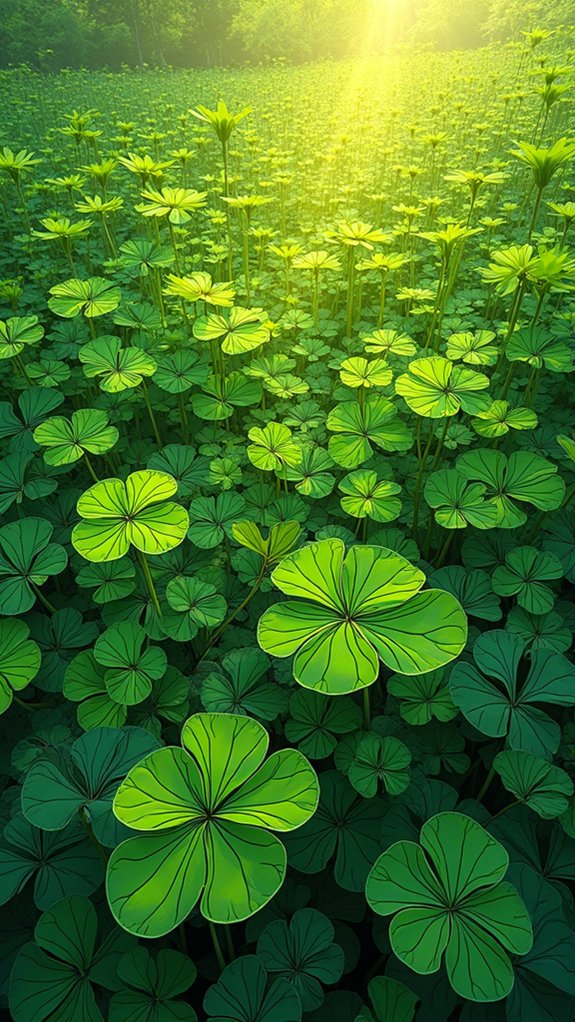
A field of doodles can look just as wild and packed as a real clover patch, especially with Clover Field Op-Art. This pattern starts with three or four teardrop shapes joined together like petals—think of them as your doodle’s clover base.
Then, by tucking a smaller teardrop inside each petal, the design pops with an awesome sense of depth. Want more clover chaos? Keep adding more teardrops around, stuffing every inch of space until the page is blooming!
The trick is that repetition—your hand gets a rhythm, and suddenly you’ve created something rich, fun, and kind of hypnotic. Even the background gets special treatment with scattering teardrops, making it extra eye-catching.
Bonus: check out affiliate links for sketching pens that make doodling even smoother!
Keith Haring Inspired Abstracts
Keith Haring inspired abstracts are all about turning simple lines and bold shapes into a wild, playful maze—one that looks like it could jump right off the page!
These chunky outlines wrap around energetic forms, creating a sense of movement that almost makes you want to start dancing with your doodles.
With every zigzag and swoop, the patterns keep things lively, letting creativity run loose and making the page feel alive (and maybe a little rebellious).
Playful Line Maze
Bold lines, playful shapes, and a maze of squiggles—this is what makes a Playful Line Maze so cool. Inspired by Keith Haring, artists use line flow techniques to guide a single, looping line around whimsical shape combinations. Imagine circles, triangles, and funny blobs, all separated just enough so the line can squiggle between them, weaving its own secret path. It’s like turning your page into a game of imaginative doodle exploration, where your pen chooses the wildest route possible! Experimenting with thick and thin lines adds drama—some paths feel bold, others almost sneak by. That maze isn’t just for looks; it dares viewers to trace every twist and turn. Grab some inspiration below:
| Maze Shape | Line Flow Idea | Exploration Tip |
|---|---|---|
| Circle | Spiral wrap | Add a jump over |
| Triangle | Zigzag route | Shrink & stack |
| Blob | Wavy swoop | Double line borders |
Bold Shape Outlines
Electric outlines zap across the page, instantly catching your eye with their thick, cartoon-like borders. It’s like someone hit the “bold” button on creativity! Inspired by Keith Haring, these doodles love dramatic, bold color contrasts—think fire-engine red against pitch black, or neon blue next to lemon yellow.
The outlines don’t just sit there, either; they buzz with dynamic figure movement, leaping or grooving right off your sketchbook. Playful pattern repetition pops up everywhere, with wiggly lines, repeating shapes, or dotted backgrounds that beg you to look twice.
Experimenting with exaggerated hands, wobbly bodies, or offbeat poses turns even the simplest shape into a character bursting with personality. Each sketch feels spontaneous, lively, and honestly, a little wild—in the best way possible.
Energetic Visual Movement
There’s something wild about the way lines can skip, hop, and bounce across a page, and nobody knew that better than artists inspired by Keith Haring.
Using dynamic abstraction techniques, they create artwork where rhythmic line movement seems to explode with life! Haring made it look easy—thick, bold lines twirl around simplified figures, filling the space with energetic color contrasts that practically shout off the paper.
Plus, the genius use of negative space lets your eyes zoom around the art, never getting bored. Want a wild doodle? Try repetitive shapes and playful patterns, just like Haring.
You might even sneak in some messages about friendship or teamwork, too—after all, a doodle can be both fun and meaningful, and that’s pure Keith Haring energy.
Flower Doodles
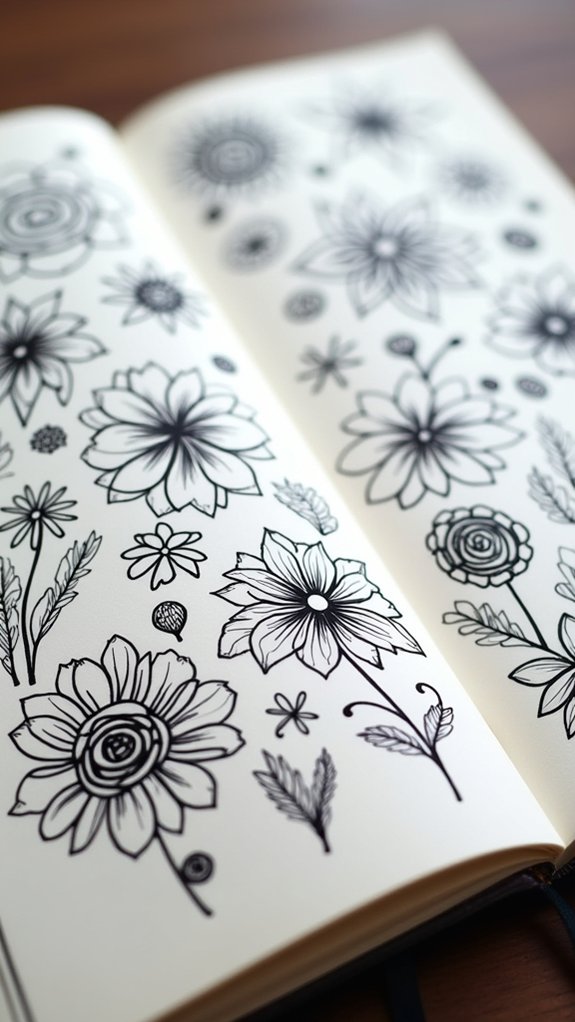
Flower doodles explode with personality, making any sketchbook page way more fun and lively.
It all starts with a simple circle—like the dot on an “i”—to anchor the middle of the bloom. From there, artists let their imaginations run wild, sketching petal variations ranging from skinny ovals to fat, wobbly swirls.
Some people layer petals to add depth or even sneak in abstract blooms that break all the classic flower rules. Going beyond just shapes, artists love to play with floral colorways, piling on patterns and lines inside each petal like secret doodle decorations.
The result? Flower doodles that burst with life, mixing fanciful style with just enough order, and turning any blank page into a mini wildflower garden—no watering can required!
Textured Mountain Landscapes
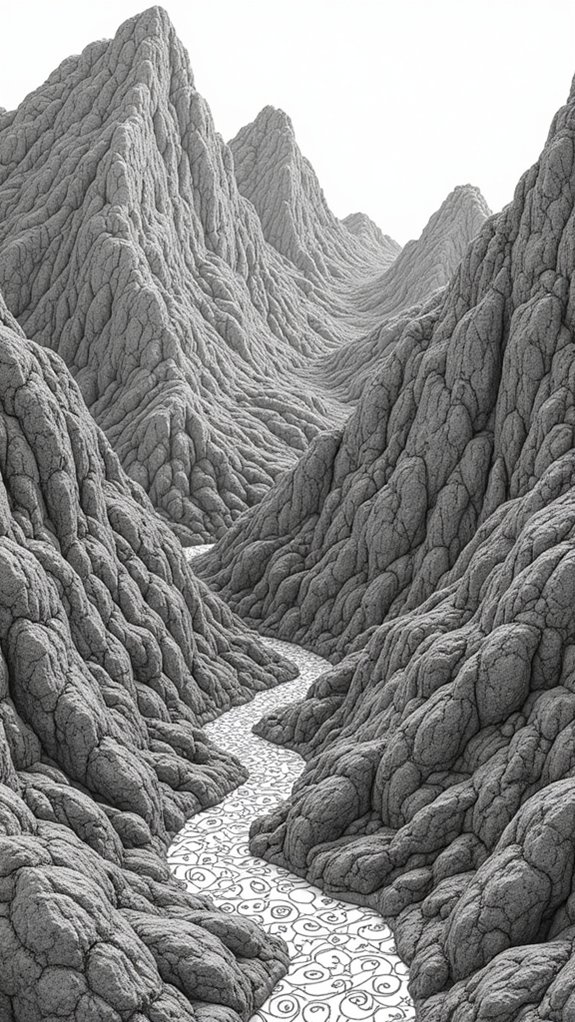
Once the page is filled with playful petals and blooming color, why not steer the sketchbook straight into wild country and start stacking up some epic peaks?
With simple mountain peak techniques, start at the bottom of the page and sketch wavy triangles—they don’t have to be perfect! Divide each shape with extra wavy lines for a bit of wild, rugged mystery.
Now, here come the shading depth effects: pick a side of each mountain and pack it with close, dark lines, turning up the drama and shadows. Blend in lighter, widely spaced lines on the other side, letting the “sun” hit those slopes.
Scenery texture variations pop out, making your scene look textured, lively, and totally adventurous—almost as if a tiny hiker could climb right in!
Modern Rose Patterns
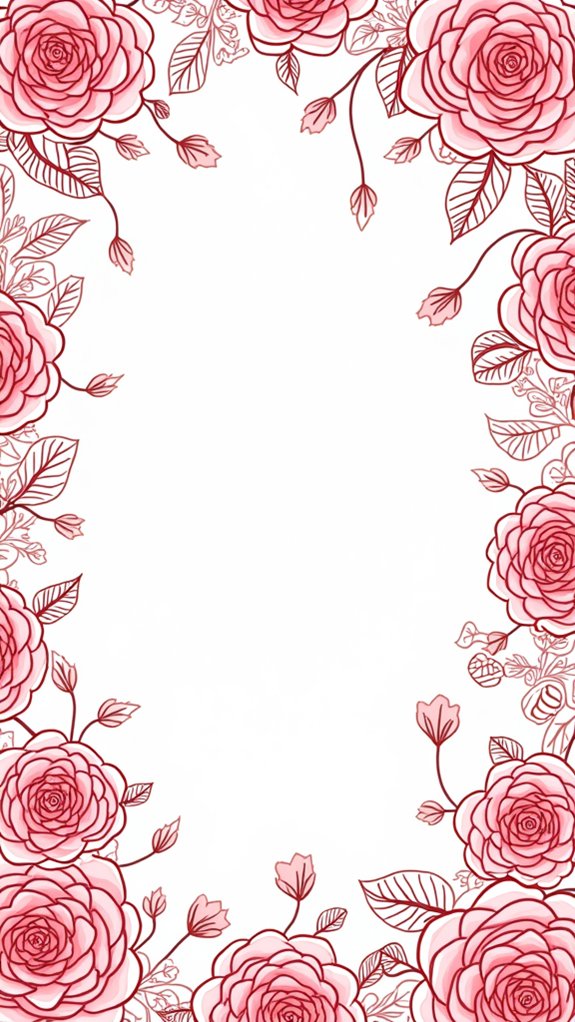
Nothing says “cool doodle” like a modern rose bursting off the page, each petal twisting and turning in its own wild way. Modern rose patterns usually begin with a tiny circle in the center—think of it as the rose’s secret hideout. Artists layer petals of all shapes and sizes around it, sometimes going abstract with swirls, zigzags, or even geometric shapes. Each abstract petal design can get a boost from intricate line textures, such as cross-hatching or teeny dots. Let’s not forget vibrant color gradients, blending bold reds, pinks, and even unexpected blues or oranges to make each rose look wild and spectacular. The table below breaks down some essential rose-inspired doodle ideas:
| Element | Creative Tip |
|---|---|
| Core Circle | Start small, grow outward |
| Petal Shapes | Mix classic, swirl, geometric |
| Line Textures | Try stippling or hatching |
| Color Gradients | Blend bold, contrasting tones |
Dynamic Drip Designs
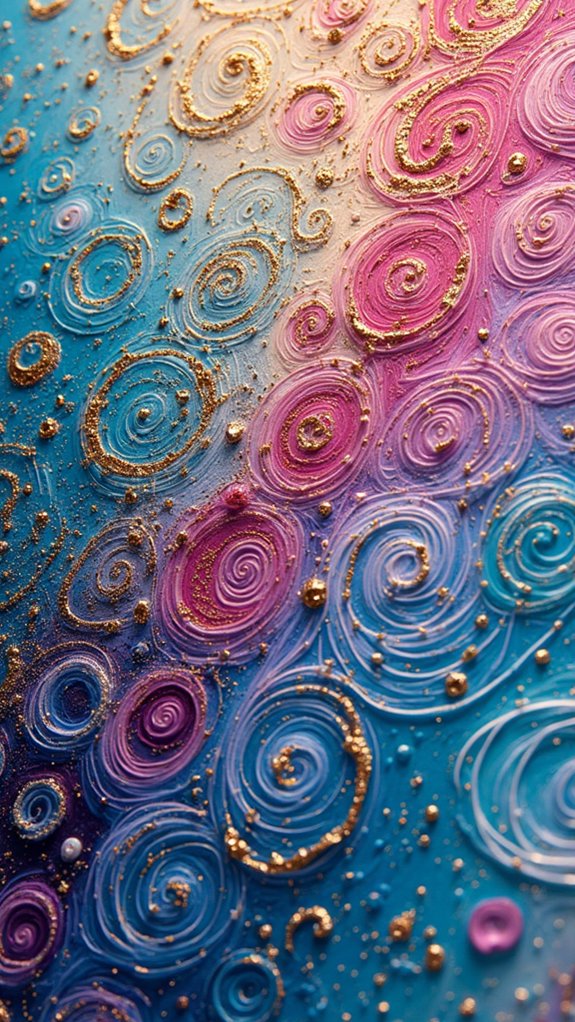
There’s something totally electric about Dynamic Drip Designs—they make a doodle feel like it’s in motion, as if the page itself just got splashed with paint.
These patterns start with a wide marker, swirling out curvy lines that slide down like melted ice cream on a summer sidewalk. With a thinner marker, artists can add smaller drips tucked inside the bigger ones, cranking up the complexity and layering effect.
Playing around with drip variations is half the fun—thick, thin, wiggly, or sharp, every line brings a new personality. The best trick? Experimenting with color combinations, because nothing shouts “eye-catching” like a neon green drip next to hot pink.
The marker techniques are so easy, even total beginners can achieve dynamic artwork that practically bounces off the page.
Rainbow Wave Lines
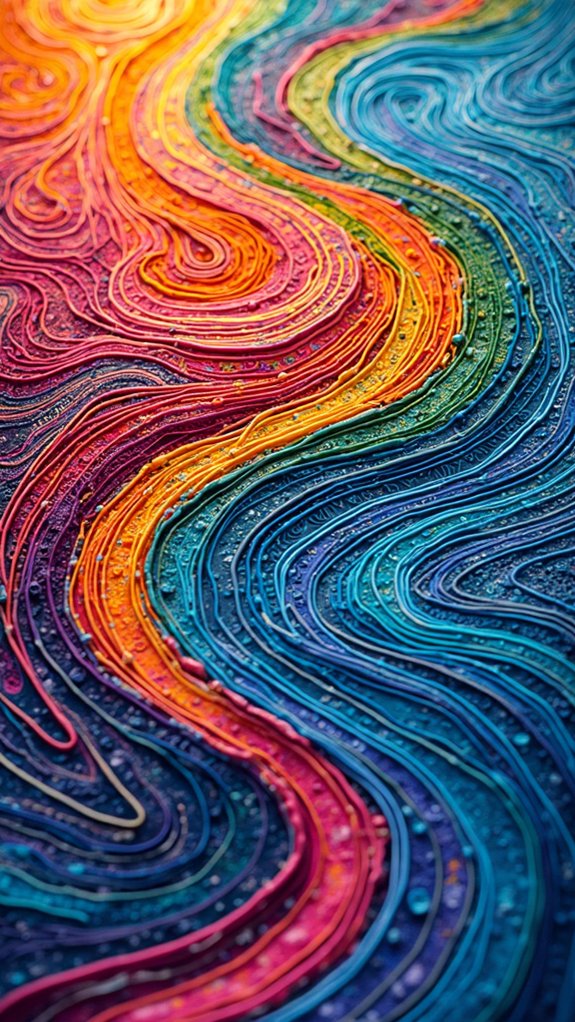
Rainbow wave lines are all about letting your lines flow like music, with each wave swooping across the page in its own funky style.
Start by sketching a bunch of wavy lines, then jazz up each space between with bold, rainbow colors—think of it as giving every wave its own snazzy outfit.
With a little attention to uniform spacing and some fearless color choices, anyone can turn a plain piece of paper into a party of color and movement.
Steps for Drawing Waves
Plenty of amazing doodle patterns start with something super simple, and wave lines are a perfect example. To immerse yourself in drawing waves, begin by sketching horizontal wavy lines across your page—think of riding a roller coaster, up and down, no seat belt needed.
Vary the height and spacing to create interesting wave dynamics. Let the lines travel all the way across the page, or let them overlap a bit for a cool layered effect. Keep your waves consistent in style, but alternate their direction, which really boosts the visual fun.
Experiment with line variation—try some thick, bold waves and some thin, gentle ones. Once your sections are set, fill each with bold, rainbow colors, using color blending techniques for smooth shifts and enchanting waves.
Adding Colorful Accents
Once the basic wave lines are rolling across the page, things start to get exciting—now it’s time to crank up the color!
Colorful accents are the secret weapon for taking those wavy patterns from “cool” to “wow.” Artists can grab markers or pens in all sorts of vibrant hues—think reds, blues, greens, and wild purples.
By filling each section formed by the wave lines with a different bright color, the design starts to pop and sizzle. Alternating the direction of the rainbow hues in each section gives the waves real movement as if they’re dancing across the page.
Want bonus style points? Mix in lines of different thickness or let the waves overlap a bit. The result: dynamic designs that are seriously eye-catching!
Wagon Wheel Circles

A giant circle on a page can look pretty mysterious, but turning it into a Wagon Wheel Circle makes it both cool and satisfying. Just imagine using neat wheel symmetry techniques—start with a big circle, mark a center hub, then zap out spokes using slick radial line designs. Want it to pop? Layer smaller circles inside the big one for groovy layered circle patterns. Play with line thickness, break the monotony with patterns in each spoke, and maybe don’t be shy with color in the wedges. This is one doodle that grabs your attention and spins it! Take a look at the steps below, and see how easy it is to ride the creativity highway:
| Step | Tip | Style Play |
|---|---|---|
| 1 | Draw large circle | Try a bold outline |
| 2 | Add center dot | Use a colored pen |
| 3 | Draw radial lines | Space evenly |
| 4 | Layer inner circles | Vary circle size |
| 5 | Decorate and color | Mix patterns/colors |
Cow Print Blobs
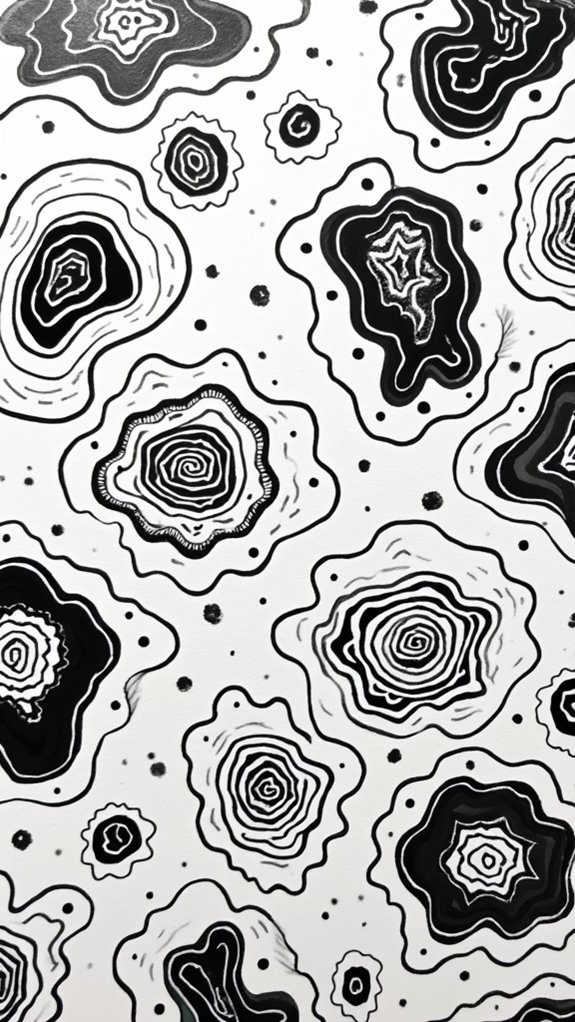
Spots gone wild—cow print blobs take the crown for quirky, eye-catching doodles that break all the rules.
These blobs are never boring, thanks to their random shapes and wild obstacle-course energy. When experimenting with cow blob variations, artists get to embrace organic shape exploration, letting each line zig, zag, and surprise.
Whether you stick to classic black-and-white or go neon with playful color combinations, these patterns are always attention-grabbers. Plus, they’re so easy anyone can jump in, no moo-sterpiece required!
- Draw big, blobby shapes—no two blobs should ever look alike.
- Fill larger blobs with smaller, funky blobs for extra fun.
- Try out wild, playful color combinations, not just black and white.
- Explore cow blob variations by experimenting with size and placement.
- Use your blobs for backgrounds, notebook covers, or even DIY fashion.
Zen Doodle Grids

Zen Doodle Grids totally mix things up—you get to draw cool sections with either neat lines or funky shapes, then fill them with all kinds of patterns, from super simple squiggles to more wild, tangled designs.
Some people like to switch up their pen sizes, going thick for shadows or thin for tiny details, and suddenly your grid looks like it’s got secret layers hiding just below the surface.
It’s kind of like a puzzle you make yourself, and the only rule is to have fun and keep your brain relaxed, even if your patterns start looking like a herd of wobbly jellybeans!
Grid Design Techniques
Even if straight lines sometimes feel a little too serious, grid design techniques can actually make doodling way more fun and creative than you might expect.
Using grid creativity tips, anyone can turn a blank page into a playground for imagination. Just sketch a light grid with pencil—no need for scary perfect lines! With symmetrical design techniques, each section of the grid becomes a tiny canvas for patterns, squiggles, or doodle creatures.
It’s like organizing chaos but in a cool way. Structured doodling methods make it easy for beginners, too. Your art looks planned but still feels surprising, which is the best combo.
- Start with light pencil grids to guide your doodles
- Experiment with different grid sizes
- Fill each box with a new pattern
- Try symmetrical designs for balance
- Enjoy how structure boosts your creativity
Pattern Variation Ideas
A whole bunch of fun pops up when it comes to filling Zen Doodle grids with pattern variations—it’s like every little box is begging for its own party. Each grid section becomes a mini playground for abstract design exploration, showing off lines, swirls, or even wild shapes. One box might get dotted with stippling, while another is covered with crisp zigzags. Mixing things up is easy, and the table below gives a few ideas that are just waiting to burst off the page.
| Spiral Swirls | Grid Crosshatch | Wavy Lines |
|---|---|---|
| Dot Stippling | Bold Zigzags | Leaf Veining |
| Checkerboard | Layered Circles | Arrow Points |
There’s also space for mixed media experimentation and texture contrast techniques—because why keep things boring when every square can surprise you?
Enhancing Depth Visually
When lines and shapes start dancing across a Zen doodle grid, something magical happens—the flat page suddenly seems to pop, showing off stacks of depth and hidden layers.
Artists who mess with Zen doodle grids discover that using depth perception techniques, visual layering strategies, and smart grid shading methods turns doodles into 3D illusions you almost want to jump into!
Each grid slice invites experiments: use more lines here, darker shading there, maybe switch up pen sizes so one section leaps forward while another melts into the background.
It gets wild how just a few changes can make your sketch swirl with dimension and complexity!
- Try darkening edges for a shadow effect
- Create patterns in layers for extra pop
- Blend patterns for soft shifts
- Play with pen thickness
- Change line directions for wild contrast
Geometric Mandalas

Geometric mandalas are like secret codes drawn in circles, triangles, and squares, each shape quietly working together to create a super-detailed pattern that looks both hypnotizing and totally impressive.
The real magic lies in their symmetrical balance—seriously, it’s like the entire design is holding hands and refusing to let go!
Drawing these patterns isn’t just about making cool art; it’s also a way to practice mindful creation, helping your brain chill out while your hands doodle away.
Mandalas have major cultural significance, too. They’re not just for sketchbooks—people have used them for ages in Hindu and Buddhist traditions as symbols for meditation.
Whether using pencils, neat colored pens, or even fancy digital tools, creating geometric mandalas means diving deep into pattern paradise!
Tangle-Inspired Borders
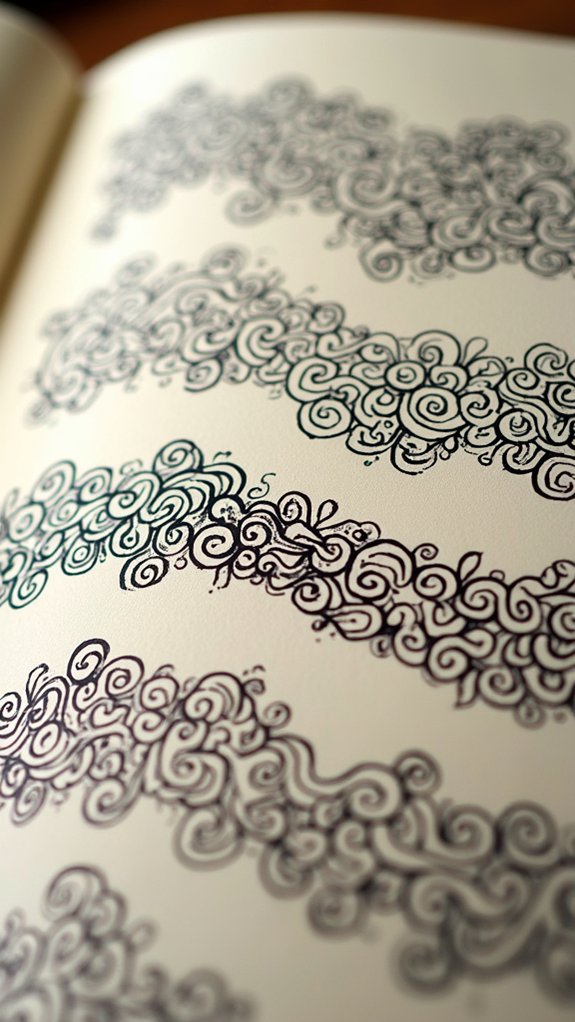
Borders can totally shake up a doodle and make the artwork pop, especially when they’re tangle-inspired. By mixing cool tangle techniques into the outer edges, artists build a fun frame that pulls everyone’s attention to the main design.
Tangle-inspired borders use repeating shapes, lines, and even little border embellishments like dots and zigzags to make everything flow together. Add in some wavy lines, spirals, or geometric shapes, and suddenly there’s movement and pattern flow that makes things super interesting!
Using thick and thin lines brings extra texture—like a comic book! Want more pizzazz? Try tossing in some bold colors for an epic contrast.
- Use wavy, spiral, or geometric shapes
- Mix up line thicknesses
- Add curve, zigzag, dot border embellishments
- Create smooth pattern flow
- Experiment with color for extra wow
Stenciled Pattern Overlays
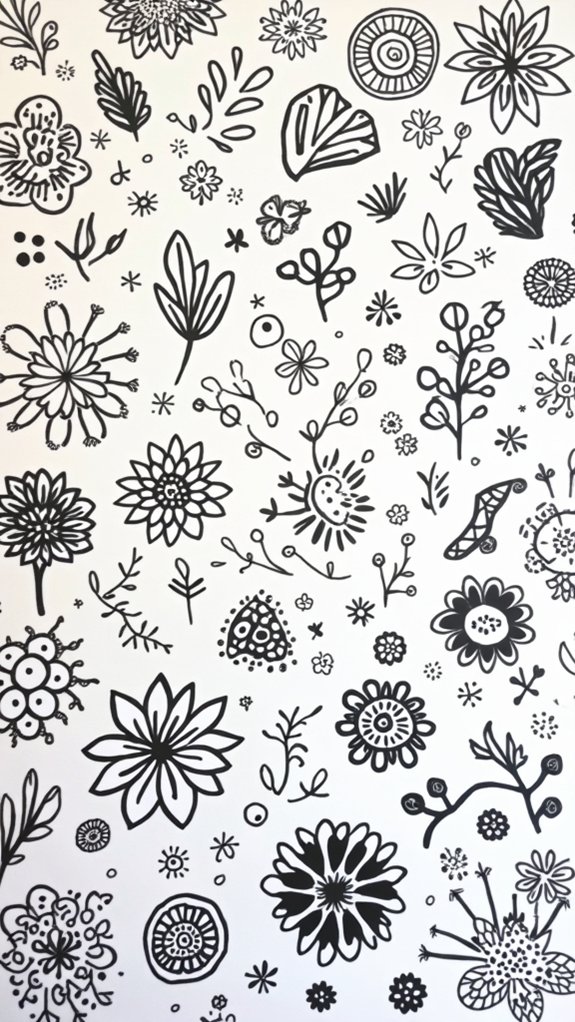
Kicking things up a notch from funky tangle borders, stenciled pattern overlays bring a whole new toolbox to the creative table. With stenciled texture techniques, anyone can look like a pro—even if drawing straight lines is a myth in your world! Stencils make sketching outlines and patterns totally doable, and you can make things pop by layering stencil designs. This is where the fun really starts: imagine mixing mediums creatively—marker, ink, watercolor, the works! The options feel endless, with geometric, floral, or wild abstract patterns ready to leap onto your page.
| Stencil Shape | Texture Result | Mediums to Try |
|---|---|---|
| Geometric Lines | Sharp, Modern | Marker, Ink |
| Florals | Soft, Organic | Watercolor, Pencil |
| Spirals | Dynamic, Playful | Gel Pen, Crayon |
| Stars | Bold, Eye-catching | Colored Pencil, Ink |
| Abstract Blobs | Funky, Unique | Paint, Mixed Media |
Patterned Frames and Borders
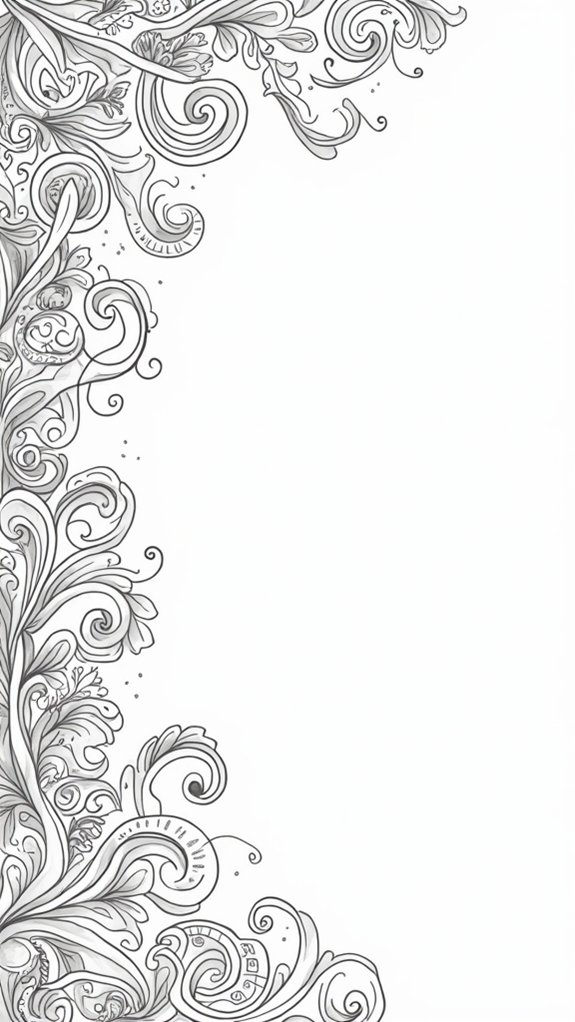
Even before picking up a pen, an artist might dream about how awesome their sketch could look with a wild, patterned frame wrapping around it.
Patterned frames and borders aren’t just fancy edges—they’re like secret doors, pulling people right into the heart of a doodle! Adding patterned textures using zigzags, dots, or swirly floral shapes brings a whole new level of border inspiration.
Mixing thick and thin lines? That’s like adding 3D glasses to your artwork. Oh, and don’t forget a splash of color! It can totally transform black-and-white borders into bold, eye-catching frames.
For artists craving a personal touch, geometric shapes and natural elements (like sneaky leaves or splashy waves) give their artistic framing a unique signature.
- Try repeating shapes like zigzags
- Mix line thicknesses for depth
- Add colors for extra pop
- Use geometric patterns
- Incorporate nature-inspired elements
Frequently Asked Questions
What Are the Best Pens or Markers for Doodle Sketching?
Selecting the best pens or markers for doodle sketching depends on desired effects and line quality. Many artists recommend fine liners for crisp detail, gel pens for smooth lines and color variety, and brush markers for expressive strokes.
How Can Beginners Develop Their Own Unique Doodle Style?
The current question explores how novices can develop a unique doodle style. Beginners benefit from studying inspiration sources, engaging in personal experimentation, and allowing natural style evolution to emerge from regular practice and creative exploration over time.
Are There Digital Tools or Apps for Creating Doodle Patterns?
When exploring digital sketching and pattern creation, users may seek app recommendations tailored for such tasks. Popular digital tools include Procreate, Adobe Fresco, and Autodesk SketchBook, each offering features for seamless doodle pattern creation on various devices.
How Does Doodling Impact Stress and Mental Health?
Research indicates that doodling benefits include reducing stress and enhancing mood. Frequently incorporated into mindfulness practices and art therapy, doodling can promote relaxation, improve focus, and support mental health by providing a calming, non-judgmental creative outlet.
Can Doodle Patterns Be Used for Commercial Art Projects?
The use of doodle branding, pattern licensing, and other commercial applications demonstrates that doodle patterns are applicable in commercial art projects, enhancing product identity and marketability across packaging, textiles, advertising, stationery, and various other creative industries.
Conclusion
So, whether you’re sketching wild spirals or experimenting with groovy mandalas, these fifteen doodle patterns are practically begging for your favorite pen. There’s no wrong way to try them—just scribble, laugh at any wobbly lines, and see what creative magic happens. Maybe you’ll fill a whole notebook, maybe just the corner of your homework, but either way, each page becomes a playground. Don’t stress about perfection; art is more fun when you let your pencil get a little wild!

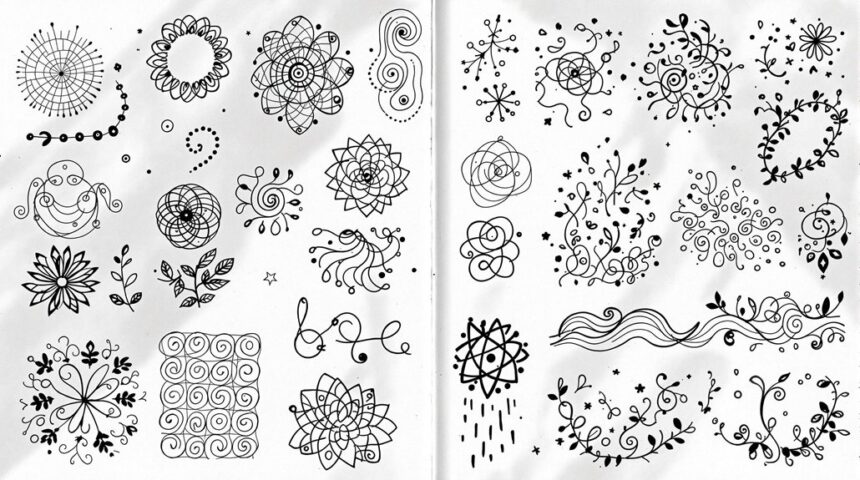
Leave a Reply